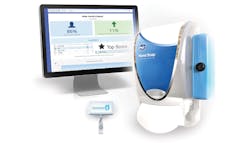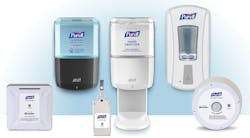A recent study by Doll et al published in Infection Control and Hospital Epidemiology noted, “Interest in electronic hand-hygiene monitoring systems (EHHMS) is now widespread throughout the infection control community.”1 And with good reason. The gold standard, direct observation, is rife with flaws. One flaw is the Hawthorne Effect, which says that people perform better when being observed. Another is that people monitoring hand-hygiene make mistakes; electronics not so much.
However, not all EHHMSs are created equally. The report advised, “Hospitals considering an EHHMS should assess the technology’s ability to accurately capture HH [hand-hygiene] performance in the clinical workflow.”1 Purchasers must evaluate systems and decide which will help their facility meet goals. A few of the questions one might ask when evaluating an EHHMS are: Does it provide real-time feedback? Can the vendor supply scientific evidence of accuracy and validity? Does it measure WHO’s 5 Moments?
Education and training
We have been told about the importance of clean healthcare worker (HCW) hands ad nauseam. Granted, there is nothing exciting about washing hands, particularly when you have to do it so many times a day the skin is dry and damaged. Tom Bergin, Healthcare Marketing Director, Professional Hygiene, Essity, offered thoughts on a novel way to keep HCWs interested in this important task. “One of the most important considerations for promoting HH compliance (HHC) is to continue to introduce new ways of engaging staff; this helps keep HH top of mind to drive behavioral change. Adopting modern technology has been a proven way to advance operational efficiencies and address hygiene compliance.”
Bergin cited a 2018 Tork survey’s findings that 68 percent of healthcare professionals believe introducing technology into their facilities has helped improve HHC. “Despite these sentiments,” related Bergin, “forty percent of these same respondents did not see their facility making a conscious effort to introduce new technology to address HHC, often citing lack of financial resources and training and education as the most common barriers.”
Bergin said Tork recently launched a solution offering a new, cost-effective way to engage staff that has built-in training and education tools. “The Tork Virtual Reality Clean Hands Training and Education application is designed to make HH training more engaging, inspiring, and interactive, using immersive virtual reality (VR) technology. The software is an evidence-based solution, developed in collaboration with behavioral scientists, world-leading experts in HH, and university hospitals around the world. The Tork Virtual Reality Clean Care solution takes a gamified approach to engaging staff on hygiene best practices and is available for free to anyone with a smartphone and a headset.”
Bergin concluded, “Hand hygiene remains the single most important factor in mitigating the spread of hospital-acquired infections (HAIs). New, cost-effective technology is delivering new ways of training staff, which will ultimately lead to more effective HHC.”
Electronic monitoring of hand-hygiene opportunities
Linda Homan, RN, BSN, CIC, Senior Manager, Clinical Affairs, Ecolab Healthcare, offered her observations on direct observation versus electronic monitoring of HH. “New Joint Commission standards on HH have increased the urgency for hospitals to improve their compliance rates. Direct observation remains the most common way for hospitals to evaluate HHC. However, hospitals are beginning to realize that the data may not be accurate. While many hospitals believe they’re achieving 90 percent compliance, studies show average HHC is less than 40 percent.2 Self-reporting and secret-shopper programs can be inaccurate, in part due to the Hawthorne Effect: when people are aware they are under observation, they modify their behavior. As a result, secret-shopper programs provide unreliable data and make it difficult to determine where corrective action is needed.”
Homan believes that healthcare facilities are increasingly employing electronic monitoring to obtain more reliable data. “Electronic monitoring allows 24/7 monitoring, eliminating the challenges associated with direct observation, and it arms infection preventionists with the data to address issues to increase HHC effectively and efficiently.”
Homan explained briefly how their EHHMS works. “The Ecolab Hand Hygiene Compliance Monitoring System uses proprietary badge and beacon technology to record individual HCWs’ HH events in a monitored patient zone set up around the patient’s bed.” She said the badges and beacons communicate to allow immediate feedback on behaviors, with visual and audible cues. “The Ecolab system allows continuous monitoring of the patient zone by individual HCWs, enabling access to accurate, actionable data to optimize the performance of individuals, units, departments, and the overall hospital.
“Customizable digital dashboards log data and provide actionable insights, allowing hospitals to pinpoint where corrective actions are needed. The Ecolab system generates compliance, equipment, and infection reports, in addition to contact investigator designations that identify staff exposure risk and isolation-room designations to ensure hospital protocol is followed.”
Homan described the successful experience of a client. “North Memorial Health Hospital, a 353-bed hospital in Robbinsdale, MN, performed a six-month pilot with the Ecolab Hand Hygiene Compliance Monitoring System in a twenty-bed surgical/medical, hematology/oncology unit.” Here is where it gets more interesting. “Direct observation by secret shoppers before the pilot reported 95 percent HHC. However, a two-week baseline compliance measurement using the Ecolab system reported actual compliance at 61.5 percent. At the end of the pilot, compliance reached more than ninety percent. The central-line–associated bloodstream infection ratio was reduced by 49 percent, catheter-associated urinary-tract infection ratios were reduced by 100 percent, and the amount of HH observations collected increased from 1,200 to 20,000.”3
These impressive results led to the Ecolab Hand Hygiene Compliance Monitoring System being implemented hospital-wide in February 2019. More than two million individual HH events have been recorded and compliance rates have improved to 88 percent.
Chris Hermann, MD, PhD, Founder and CEO, CLEAN HANDS – SAFE HANDS (CHSH), also has observed that EHHMSs are being employed more often. “We’re seeing wider adoption of EHHMS technology in the marketplace, with many health systems adopting it on a large scale. If you consider a typical technology adoption curve, adoption is no longer limited to ‘innovators’ and ‘early adopters’; we’re now seeing explosive growth into the ‘early majority’ phase.
“We’ve heard The Leapfrog Group’s 2019 survey includes an optional question as to whether or not hospitals are using EHHMSs, and, if so, which system,” continued Hermann. “We’re told that this question will be mandatory in 2020 and anticipate this will help further accelerate adoption.”
Here is how it works: “CHSH system uses a Real-Time Voice Reminder to gently remind clinicians, in the moment, when they forget to clean their hands. When the voice is turned on, HH typically more than doubles, and HAIs drop by nearly 70 percent. The CHSH system also offers Real-Time Text Messaging, which sends a text message to unit leadership when HH is below an expected level in a patient room, several hours into a shift, when there’s time to address issues and prevent an infection from spreading.”
Another feature is Adaptive Room Modes, which allows staff to change room modes quickly, based on patient conditions, such as giving more time to gown and glove for isolation rooms. In Clostridium difficile mode, the voice reminder tells clinicians to use soap and water when exiting the room. Credit is not given for using sanitizer.
The Hand Hygiene Acceleration Pathway is a “six-phase process that focuses clinical teams on particular goals for each phase, reinforcing new habits and increasing performance over time, explained Hermann. “The pathway uses gamification to engage clinicians in a positive way, an approach that has shown to be more effective than simply installing technology and walking away.”
Hermann also made the point that “HAIs were reduced by an average of 66.5 percent in the most recent, consecutive, fifteen hospital installations where our process was followed for at least six months.”
Tim Cambier, SMARTLINK Business Development Senior Director, GOJO Industries, Inc., also talked to Healthcare Purchasing News about technology’s tremendous effect on quality health care. “Connected devices, big data, real-time location systems, wearable devices, artificial intelligence, and machine learning are all being explored or adopted by hospitals to replace or supplement the manual method of collecting observational HH data, with the ultimate goal of improving the quality of patient care. Electronic monitoring solutions can monitor 24/7 and provide robust data that can be used to ensure patient safety. The advancement of these technologies means there are different levels of monitoring solutions, including group monitoring systems, or person-specific monitoring systems.
“Earlier this year, GOJO expanded the PURELL SMARTLINK portfolio to include the Integrated Monitoring System (IMS),” said Cambier. He claimed that this addition affords them “the broadest set of EHHMSs in the market, “allowing GOJO to offer customers a solution no matter where they are in their HH monitoring journey. IMS uses Bluetooth Low Energy technology to capture HCW-specific HH in real-time, providing hospitals with various visual representations of data that can be used for real-time feedback, and to identify areas of improvement.”
Understanding that all healthcare facilities have not yet managed to come up with the resources to make a giant technological leap to more involved EHHMSs, Cambier, added, “GOJO also offers a direct-observation mobile application, group monitoring, dispenser-service monitoring and clinician-based support with HH expertise to help educate and coach behavior change. GOJO also partners with several major real-time location systems companies to integrate HH monitoring with asset tracking, nurse call, and patient monitoring.”
In support of GOJO’s claims of efficacy, Cambier related the experience of a ninety-three-bed, nonprofit hospital in Pennsylvania that adopted GOJO’s PURELL SOLUTION, including PURELL SMARLTINK monitoring technology and PURELL Clinician-Based Support. “The use of this technology, in combination with clinical interventions supported by clinical experts, resulted in an improved and sustained HH rate of 80 percent over their baseline activity. This proves that technology alone is not enough, and complementary behavioral interventions are essential to success in improving HH and reducing the spread of infections.”4
Hand-hygiene products
Skin damage from repeated hand cleansing is a major reason for non-compliance with HH protocols. Advanced HH cleansing products can encourage proper HH best practices by being formulated in such a way that it helps to break the cycle of damaged skin due to constant hand cleansing.
Another reason for noncompliance can be inconvenience. Holly J. Montejano, MS, CIC, CPHQ, PDI Clinical Science Liaison, offered insight on the impact of convenient products on HHC. “PDI’s Sani-Hands Instant Hand Sanitizing wipes are available in various forms of packaging to drive compliance, including single wipes, bedside packs, and pop-up canisters.” She explained that emollients in the wipes, including vitamin E and Aloe, combat the drying effects of alcohol on the skin.
“Product placement within the patient zone is key to compliance,” said Montejano. “Sani-Hands wipes are packaged to allow for the HCW to have product on hand, and it comes in a bedside pack for the patient to use, so that no opportunities are missed.” Montejano averred that Sani-Hands wipes outperform alcohol-based hand rubs in microbial-log reduction, and, she said, “The wipe aids in the removal of dirt while killing bacteria.”
Montejano connected the dots between clean hands and thwarting antimicrobial resistance. “Healthcare worker and patient hands can easily become contaminated, because germs are ubiquitous in the healthcare environment. Our hands often provide a free ride to germs.
“Research published in Clinical Infectious Diseases showed the transmission potential of multidrug-resistant organisms (MDROs)—methicillin-resistant Staphylococcus aureus, vancomycin-resistant enterococci (VRE), and resistant gram-negative bacilli—from patient hands to their surrounding environment.5 Patients were cultured on admission, on days three and seven, and weekly until they were discharged. Sites of cultures included patient nares, dominant hand, and six high-touch environmental surfaces within the patient room. Patients with MDROs found on their hands were also found to have environmental surfaces contaminated with MDROs.”5
Montejano cited the experience of a 495-bed university-affiliated medical center where Sani-Hands wipes were shown to reduce C difficile rates successfully via patient and staff HH education.6 “Bedside packs were made available to bed-bound patients, thus driving patient compliance. Authors concluded, ‘Although alcohol is not considered to be an effective agent for killing C difficile spores, it can be theorized that the alcohol wipes provided mechanical cleansing of the patients’ hands, which removes organic debris and, potentially, spores from the skin surface’.”6
Martin McGonagle, General Manager, Healthcare, SC Johnson Professional, noted the frequency with which HCWs must clean their hands contributes to damaged, dry skin. “During each shift, HCWs following correct HHC may wash and sanitize their hands 100-plus times. When HH is practiced this frequently, restoring the skin’s natural moisture can become just as important as killing microorganisms, as irritated skin can quickly become a barrier to proper HH. SC Johnson Professional offers a portfolio of products formulated with the unique needs of healthcare workers in mind. Our mild formulations cleanse hands without negatively impacting the skin’s natural moisturizing factors.
“SC Johnson Professional worked with leading HH experts to develop an EHHMS that measures compliance against WHO’s My 5 Moments for Hand Hygiene.” According to McGonagle, their system “remains the first and only research-based, badge-free system that measures HH performance during direct patient care and provides accurate compliance scores based on all My 5 Moments. By continuously socializing group HH performance data, and utilizing SC Johnson Professional engagement tools, hospital teams generate collaboration, improve performance, and support the development of a just culture.”
Ever important, McGonagle pointed to evidence of their product’s efficacy. “Research performed at Greenville Health System in South Carolina (now Prisma Health Upstate) demonstrated that electronic measurement and the use of HHC insights based on the WHO 5 Moments, enabled a 746-bed teaching hospital to drive significant HHC improvements of 25.5 percent; reduce hospital onset methicillin-resistant Staphylococcus aureus infections by forty-two percent; and reduce costs by $434,000 over the study period.7
“This work reinforces the relationship between HH and the spread of microorganisms, and it demonstrates how technology and the routine socialization of HH insights can help hospitals combat the complex and dangerous problem that is poor HHC.”
Kimberly Prinsen, RN, MSN, Technical Service Specialist, 3M Medical Solutions Division, 3M, also highlighted their solution to damaged, dry HCW hands. “We understand the demands placed on the healthcare provider’s hands from repeated hand cleansing throughout the day. That is why we invented 3M Avagard Chlorhexidine Gluconate 1 percent And Ethyl Alcohol 61 percent, W/W Surgical and Healthcare Personnel Hand Antiseptic with Moisturizers. When a healthcare provider cleanses their hands up to ninety times a shift, it is important to have a product that not only cleanses but protects and enhances hand heath. Our proven formulation of chlorhexidine gluconate, alcohol, and moisturizers does just that.”
In addition to promoting hand health, Prinsen emphasized that their product also encourages compliance. “There are multiple ways that 3M Avagard CHG promotes compliance. First, when the pump is activated, a pre-measured dose is dispensed into the hand of the healthcare provider. Using the right amount of product ensures its efficacy. The right amount also promotes skin health, as too much of any product can cause skin irritation. Second, there is no time requirement as to how long Avagard CHG must be applied to the hands, unlike other HH products. You simply rub it into your hands and allow it to dry. It is quick and easy to use. In addition, the proven persistent property of the active ingredient, chlorhexidine gluconate, has a cumulative effect with repeated use. This means greater protection for both the healthcare providers and the patients they are caring for.”
Prinsen continued, “One of the most important components to reducing the spread of infection throughout any healthcare facility is proper HH. The clinicians, the patients, and the visitors all play a critical role. In the advent of increasing prevalence of MDROs, HH should continue to play a primary role in a hospital’s infection-prevention program. If everyone were to practice proper HH, there would be a reduction in overall transmission of organisms.”
References
1. Doll ME, Masroor N, Cooper K, et al. A comparison of the accuracy of two electronic hand hygiene monitoring systems. Infect Control Hosp Epidemiol. 2019 Aug 13;:1-4. doi: 10.1017/ice.2019.209. [Epub ahead of print]
2. Centers for Disease Control and Prevention. HAI Data. Last accessed September 3, 2019.
3. Bor B, Swanson S, Olson D, et al. Bringing hand hygiene to the next level. Presented at APIC-MN; September 27-28, 2018; Minneapolis, MN. Abstract.
4. Boyce JM, Laughman JA, Ader MH, et al. Impact of an automated hand hygiene monitoring system and additional promotional activities on hand hygiene performance rates and healthcare-associated infections. Infect Control Hosp Epidemiol. 2019;40:741-747. https://www.cambridge.org/core/services/aop-cambridge-core/content/view/12A61417C789A3CC814172D645D11840/S0899823X19000771a.pdf/impact_of_an_automated_hand_hygiene_monitoring_system_and_additional_
promotional_activities_on_hand_hygiene_performance_rates_and_healthcareassociated_infections.pdf. Last accessed September 3, 2019.
5. Mody L, Washer LL, Kaye KS, et al. Multidrug-resistant organisms in hospitals: what is on patient hands and in their rooms? Clin Infect Dis. 2019 Apr 13. pii: ciz092. doi: 10.1093/cid/ciz092. [Epub ahead of print]
6. Pokrywka M, Buraczewski M, Frank D, et al. Can improving patient hand hygiene impact Clostridium difficile infection events at an academic medical center? Am J infect Control. 2017 Sep 1; 45(9):959-963.
7. Kelly JW, Blackhurst D, McAtee W, et al. Electronic hand hygiene monitoring as a tool for reducing health care–associated methicillin-resistant Staphylococcus aureus infection. Am J Infect Control. 2016 Aug 1;44:956-957.
About the Author

Susan Cantrell
Susan Cantrell is Infection Prevention Editor for Healthcare Purchasing News.







